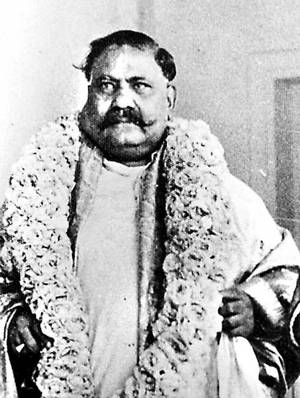Hyderabad, TELANGANA :
Kolkata :

Seasoned musicians paid melodic tributes to Ustad Bade Ghulam Ali Khan on his 115th birth anniversary in Kolkata.
The Calcutta School of Music, in association with Saambhavi, offered homage to Ustad Bade Ghulam Ali Khan on his 115th birth anniversary (2nd April) at the century-old School’s Sandré Hall. The evening touched the nostalgic chord when Pandit Buddhadev Dasgupta who, despite his ailment, came to share his treasured memories related to Khansaheb with the audience, sobbed like a child while listening to ‘Hari Om Tatsat’, soulfully sung by Nabhodeep Chakraborty, a young torchbearer of Kasur Patiala Gharana who religiously pays melodic tributes to Khansaheb on this day every year and who conceptualised this event.
According to Dasgupta, the erudite sarod maestro who is an ardent admirer and delightful analyst of Khansaheb’s charismatic music, “Among those legendary musicians who spent part of their lives in the city of joy are Ustad Amir Khan and Ustad Bade Ghulam Ali Khan. The styles of both the ustads had the biggest impact on local vocalists and quite a few Bengali musicians, without any direct taaleem have tried to blend their styles with results which often are little short of disastrous.”
Fortunately, Chakraborty, having been trained by Ustads Raza Ali Khan, Mazhar Ali Khan and Jawad Ali Khan, grandson and grand-nephews of Khansaheb, has acquired enviable gharana treasures.
Extraordinary rehearsal
He insists on the ‘Kasur’ prefix. This has a valid reason. ‘Khansaheb hailed from Kasur, a small town 30 kilometers away from Lahore; and the people still remember the superhumanly riyaaz of ‘Kasuri Bade Ghulam’, says Chakraborty. “It was Khansaheb, who modified the original Patiala style which basically thrived on taans. (Khansaheb’s son) Ustad Munawwar Ali Khan went on record while describing the olden, somewhat rough, gayaki, ‘Aisa lagta tha jaise billiyan jhagad rahi hain (it sounded as if cats were fighting)’.”
The evening was based on some select compositions of Ustad Bade Ghulam Ali Khan under the pseudonym ‘Sabrang’. A clutch of Chakrborty’s disciples presented these khayal bandish-s with sincere reverence. Each one focused on a special aspect of their gharana’s salient features. They were ably supported by Timir Baran Chakraborty on tabla.
Among them Sagnik Sen, a child prodigy who possesses ‘Classical Voice of India 2013’ title, stood out for his short but amazingly matured and melodious presentation of two compositions in ragas Bhimpalasi and Multani. The anecdotal history of every gem, displayed during the course of this edifying evening, revealed that Khansaheb believed in ‘Sab din nahi hot ek samaan’ (Multani); that he sang in praise of ‘Dev Maheshwara’ (Bhupali); that he penned a composition in Megh but sans the description of Monsoon and often sang it in Madhmad Sarang.
In the latter part of the evening, Nabhodeep Chakraborty, accompanied by Amit Chatterjee (tabla) and Keshab Banerjee (harmonium) presented a bandish in Koheri Kalyan, one of the most heard ragas invented by Khansaheb; the others being Andoli ka Sarang, Malini Basant, Hariruddh (named after a river in Afghanistan, this raga blends Dhani and Malkauns).
His selection also included a Malkauns tarana, set to Asul-e-Fakhta tala of five beats that interprets the rhythm of the fluttering wings of a bird (Fakhta). A rare Maand from the unpublished records of Khansaheb was Chakraborty’s last piece but encores led him to ‘Hari Om Tatsat’- one of the unforgettable compositions, immortalised by Khansaheb. The screening of a documentary film on the life and music of Ustad Bade Ghulam Ali Khan topped it all.
source: http://www.thehindu.com / The Hindu / Home> Entertainment> Music / by Meena Banerjee / April 27th, 2017









